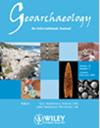Planetary geoarchaeology as a new frontier in archaeological science: Evaluating site formation processes on Earth's Moon
IF 1.4
3区 地球科学
0 ARCHAEOLOGY
引用次数: 1
Abstract
On October 4, 1957, Homo sapiens crossed a new threshold of technological innovation after constructing an artifact capable of entering Low Earth Orbit and effectively paving the way for a future of space exploration. This artifact was Sputnik 1, launched by the Soviet space program which triggered the “space race” of the mid‐20th century. Over the past 65 years, we have continued to explore and populate our solar system with rockets and spacecraft including satellites, probes, landers, and rovers. This expansion into our solar system has left traces of our presence on several planets including the Earth, Mars, Mercury, and Venus along with Earth's Moon, Titan, and several galaxy travelers in the form of asteroids and comets. Today, we have entered the realm of a new privatized and global space race, effectively a “new space race” or “new Space Age.” As we expand our material footprint into new extraterrestrial environments, there is a growing need to understand the types of unique site formation processes capable of altering, destroying, or preserving this rapidly increasing archaeological record known as space heritage. Such understandings are germane to the subdiscipline of geoarchaeology, that part of archaeology dedicated to studying the interaction between humans, cultural heritage, and environmental systems from a geoscience perspective. Closely aligned and partially overlapping with the subdisciplines of space archaeology, archaeological science, and planetary geology, we introduce a new subfield we call planetary geoarchaeology to open discussion about how geoarchaeologists can play a role in addressing current and future issues surrounding the preservation and management of space heritage. To demonstrate the potential of the subdiscipline, we focus on the current archaeological record of the Moon, describe lunar site formation processes, and discuss the implications for the current and future preservation of space heritage in the lunar setting. Planetary geoarchaeology can be applied to practically every type of extraterrestrial environment, provided humans have left behind a measurable record. We hope this paper will spur more research studying human–environment interaction in space.行星地质考古学作为考古科学的新前沿:评价地球月球上的遗址形成过程
1957年10月4日,智人建造了一个能够进入近地轨道的人工制品,并有效地为未来的太空探索铺平了道路,从而跨越了技术创新的新门槛。这件人工制品是苏联太空计划发射的人造卫星1号,引发了20世纪中期的“太空竞赛”。在过去的65年里,我们继续用火箭和航天器探索和填充我们的太阳系,包括卫星、探测器、着陆器和漫游车。这种对太阳系的扩张在包括地球、火星、水星和金星在内的几颗行星上留下了我们存在的痕迹,还有地球的月球、泰坦,以及小行星和彗星形式的几个星系旅行者。今天,我们已经进入了一个新的私有化和全球太空竞赛的领域,实际上是一个“新太空竞赛”或“新太空时代”。随着我们将物质足迹扩展到新的地外环境,人们越来越需要了解能够改变、破坏、,或者保存这种迅速增加的被称为太空遗产的考古记录。这种理解与地质考古学的子学科密切相关,地质考古学是考古学的一部分,致力于从地球科学的角度研究人类、文化遗产和环境系统之间的相互作用。我们与空间考古、考古科学和行星地质学的子学科紧密一致并部分重叠,引入了一个新的子领域,我们称之为行星地质考古,以公开讨论地质考古学家如何在解决当前和未来围绕空间遗产保护和管理的问题中发挥作用。为了证明该分支学科的潜力,我们重点关注月球的当前考古记录,描述月球遗址的形成过程,并讨论对当前和未来在月球环境中保护太空遗产的影响。只要人类留下了可测量的记录,行星地质考古几乎可以应用于所有类型的地外环境。我们希望这篇论文能激发更多研究太空中人与环境相互作用的研究。
本文章由计算机程序翻译,如有差异,请以英文原文为准。
求助全文
约1分钟内获得全文
求助全文
来源期刊

Geoarchaeology-An International Journal
地学-地球科学综合
CiteScore
3.60
自引率
5.90%
发文量
51
审稿时长
>12 weeks
期刊介绍:
Geoarchaeology is an interdisciplinary journal published six times per year (in January, March, May, July, September and November). It presents the results of original research at the methodological and theoretical interface between archaeology and the geosciences and includes within its scope: interdisciplinary work focusing on understanding archaeological sites, their environmental context, and particularly site formation processes and how the analysis of sedimentary records can enhance our understanding of human activity in Quaternary environments. Manuscripts should examine the interrelationship between archaeology and the various disciplines within Quaternary science and the Earth Sciences more generally, including, for example: geology, geography, geomorphology, pedology, climatology, oceanography, geochemistry, geochronology, and geophysics. We also welcome papers that deal with the biological record of past human activity through the analysis of faunal and botanical remains and palaeoecological reconstructions that shed light on past human-environment interactions. The journal also welcomes manuscripts concerning the examination and geological context of human fossil remains as well as papers that employ analytical techniques to advance understanding of the composition and origin or material culture such as, for example, ceramics, metals, lithics, building stones, plasters, and cements. Such composition and provenance studies should be strongly grounded in their geological context through, for example, the systematic analysis of potential source materials.
 求助内容:
求助内容: 应助结果提醒方式:
应助结果提醒方式:


